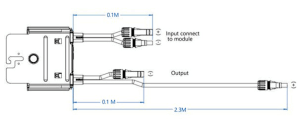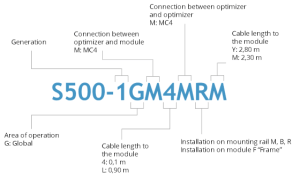SolarEdge S440 and S500 optimizers – P series replaced by the new S series
SolarEdge is optimizing its product portfolio. At Intersolar 2021, the company presented the new SolarEdge S440 and S500 optimizers. Below we show you what these optimizers can do and which products they replace.
The latest P-series of SolarEdge optimizers will be replaced by the new S-series. The goal of this change is to optimize the product range and thus to have fewer individual products and product numbers. By doing so, SolarEdge is also responding to the new generation of PV modules with higher power classes and short-circuit current. In the future, the SolarEdge S440 and S500 optimizers will be available as individual optimizers. In the medium term instead, the company is planning to launch another optimizer for thin-film modules and an additional one for shorter strings.
 SolarEdge optimizer P401-5RM4MRM
SolarEdge optimizer P401-5RM4MRM
Technical details of the SolarEdge optimizer
With 14.5 A, the new SolarEdge S440 and S500 optimizers fully support all short-circuit currents (Isc) of the modules which are currently available on the market, but there is still room for improvement, as the power optimizers are currently overdimensioned. In the future, we are expecting modules with an output exceeding 400 Wp. The SolarEdge S440 and S500 optimizers are also designed for these outputs. These are the product specifications regarding power, short-circuit current, string length and connectors of the S optimizers:
- S440-1GM4MRM: Modules up to 440 Wp and 14.5 A Isc / 1 phase: 8-25 modules per string / 3 phases: 16-50 modules per string / MC4 connector
- S500-1GM4MRM: Modules up to 500 Wp and 14.5 A Isc / 1 phase: 8-25 modules per string / 3 phases: 16-50 modules per string / MC4 connector

Interconnection of the optimizers
SolarEdge optimizer S440 and its advantages
For the S series, SolarEdge has improved the cable management and now opts for shorter cables. This prevents the connectors from laying on the roof cladding. In addition, the optimizers recognise when PV connectors do not behave properly and help preventing possible safety problems by transmitting the related data to the installer or to the monitoring app, in the event for example of electric arcs or of higher temperatures in the proximity of the connectors.

Installation and cable lengths of the power optimizers
The serial number of the optimizers reveals many technical details of the SolarEdge S440 and S500 optimizers and contains information about the cable length, the plug connection and the optimizer generation.

Be careful when choosing an optimizer
The optimizer output must correspond to that of the module or at least be cleared for release for that module output range. Otherwise, this can lead to malfunctions and warranty problems. Another very important factor you should keep in mind is the open-circuit voltage and the short-circuit current of the solar modules, which must not exceed that of the optimizer. You can easily compare the values in the data sheets.
The S440 and S500 power optimizers optimise each individual module of your PV system. This way, the weakest module does not affect the power of the entire string. Instead, each module delivers the maximum possible current. The SolarEdge Designer helps you find the right optimizer for your PV modules.
Conclusion
The new SolarEdge S440 and S500 optimizers are a response to new module generations and output trends. They are technically compatible with all PV modules currently available on the market and offer potential for further improvements. Thermal monitoring of the connectors makes the system even safer. At the same time, the price-performance ratio has been improved.
Summary
- The new SolarEdge S440 and S500 optimizers are compatible with all module versions currently on the market.
- Module optimizers get the most out of your PV modules. With the new S series, the optimizers are also suitable for modules with more than 400 Wp.
- The serial number provides information about the cable length, the version and the connector.


